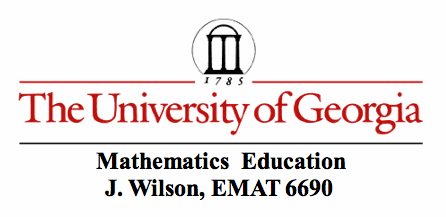
8th grade Instructional Unit
Unit 2 – Exponents & Square Roots Review
Unit 3 – Pythagorean Theorem Instructional Unit
by
Nancy Perzel
Day 7 - Converse & Pythagorean Triples
Warm-Up:
1) A 20ft. ladder is leaned against a wall. If the base of the latter is 8 feet from the wall, how high up on the wall will the ladder reach?
Draw a picture of this
situation. Label what you
know. Warm-Up GSP file
Bring students together for a discussion… Can you solve this problem? They may not be familiar solving for a missing side length of a right triangle (other than the hypotenuse), but they can apply the steps they’ve taken in the past to solve this problem! Walk them through the process. Page 2 of the GSP file.
Activity 1:
Introduce the converse of the Pythagorean Theorem – if the square of the length of the longest side of a triangle is equal to the sum of the squares of the lengths of the other two sides, then the triangle is a right triangle.
Determine if the following side lengths would form a right triangle. How do you know? Explain why or why not? It’s important to remember that the hypotenuse (c) is always the longest side!!!
1) 9, 40, 11
2) 25, 24, 7
If we know (a) and (c), can you find the length of (b)? And vice versa?
3) a= 12, c = 13
4) b = 6, c = 10
Draw a picture, or use GSP to make a visual of the following situation.
5) The base of a 15-foot ladder is placed 9-feet from a wall. If the ladder leans against the wall, how high will it reach?
6) Jack has let out 40m of kite string when he observes that his kite is directly above Jill. If Jack is 25m from Jill, how high is the kite? Pages 3 & 4 of the GSP file.
Activity 2:
Pythagorean Triple – a set of three whole numbers that can be lengths of sides of a right triangle. Students can verify that a set of three numbers is a Pythagorean Triple, by using the equation a2 + b2 = c2.
Some of the most common examples:
3 4 5 (revisit Day 3,
Example 3 – the diagonal line would be the hypotenuse…)
5, 12, 13
7, 24, 25
8, 15, 17
9, 40, 41
11, 60, 61
Pythagorean triples can
be generated by using multiples of the numbers in the known triple as shown
below:
|
|
Multiples
of 3, 4, 5 |
Multiples
of 5, 12, 13 |
Multiples
of 8, 15, 17 |
|
Multiply by 1: |
3, 4, 5 |
5, 12, 13 |
8, 15, 17 |
|
Multiply by 2: |
6, 8, 10 |
10, 24, 26 |
16, 30, 34 |
|
Multiply by 3: |
9, 12, 15 |
15, 36, 39 |
24, 45, 51 |
|
Multiply by 4: |
|
|
|
|
Multiply by 5: |
|
|
|
Additional
Practice/ Homework Assignment:

Technology Resources:
http://www.brainpop.com/math/geometryandmeasurement/pythagoreantheorem/preview.weml
Return to 8th grade Instructional Unit
Return to Nancy Perzel's Home Page